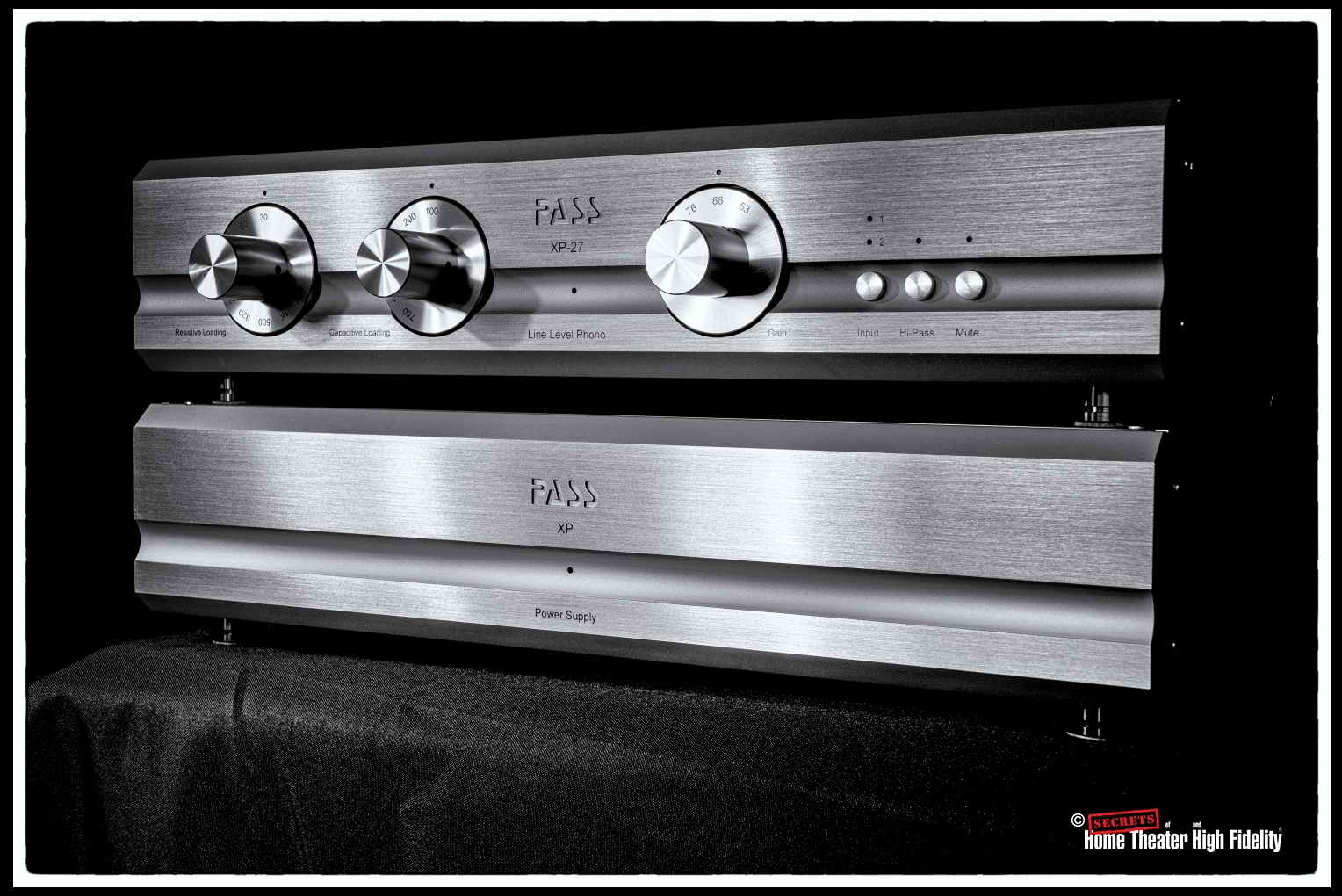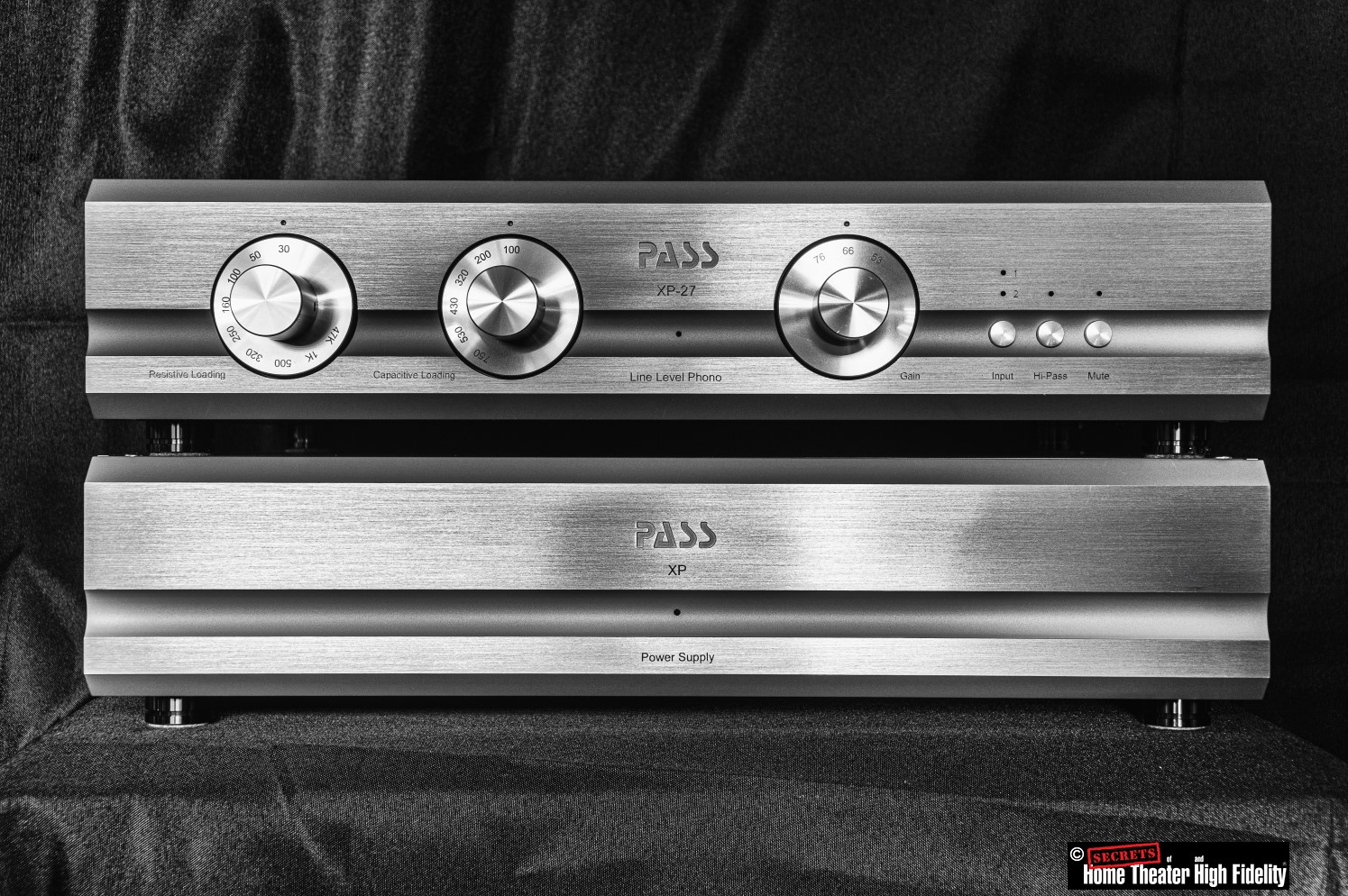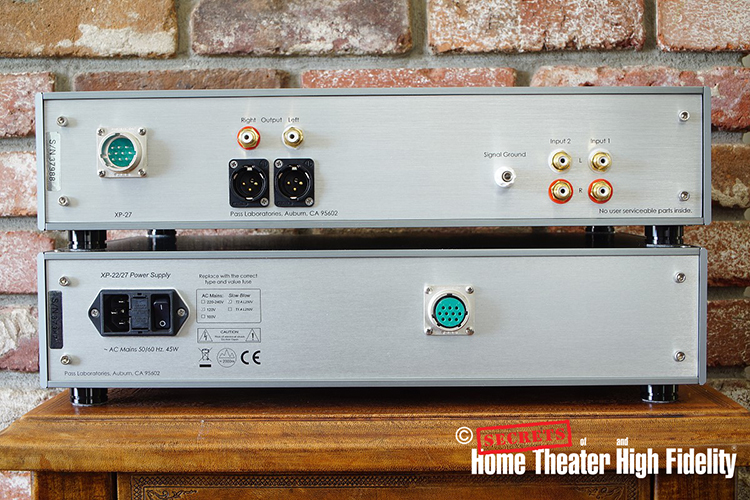Pass Labs is a pre-eminent USA manufacturer of solid-state preamplifiers and power amplifiers. Many of the power amplifiers are Pure Class A biased, and of course, all their preamplifiers are Pure Class A. Their new XP-27 Phono Preamplifier is a two-chassis unit, weighing in at 45 pounds (total for the two chassis). That is more than some power amplifiers.
The sound is truly “something else”, the sub-title of one of my jazz albums. Superb detail and clarity are its hallmarks. It has plenty of gain for use with any MC or MM phono cartridges. The exterior industrial design is worthy of Vogue Magazine.
I have been a big fan of Pass Labs for many years. Their products have always sounded and tested like the terrific units they are. The new XP-27 is no exception. Characterized by low distortion, clarity, and excellent detail, it is worthy of any high-end audio system. It’s heavy and expensive, which are adjectives that describe all of their preamplifiers and power amplifiers, many of which are Pure Class A biased.
Pass Labs XP-27 Phono Preamplifier
- OMG sound quality
- High gain without transformer
- Heavy build – heavy is good
- Two input sets
- XLR balanced outputs (and RCA unbalanced)
Gain Settings:
53, 66, 76 dB
Inputs:
2
RIAA Response:
± 0.1 dB, 20 Hz – 20 kHz
Power Consumption:
50 Watts
Number of Chassis:
2
Dimensions (each chassis):
17” W x 12” D x 4” H
Total Weight:
45 Pounds
MSRP:
$11,500 USD
Website:
Company:
SECRETS Tags:
Pass Laboratories, Pass Labs, Pass Labs XP-27 Phono Preamplifier, Phono Preamplifier, Pass Labs Phono Preamplifier, XP-27 Phono Preamplifier, Preamplifier Review 2021
Let’s talk about what a phono preamplifier is and what it does. First, if you have a turntable, you will need a phono preamplifier. Some turntables come with one inside. Otherwise, you will need one further downstream, either in your main preamplifier (some preamplifiers, integrated amplifiers, and processors come with one), or an outboard phono preamplifier separate from your main preamplifier. Your main preamplifier won’t work alone because the output of a phono cartridge is only about 0.25 mV to 7 mV, and this is too low for your main preamplifier.
The phono preamplifier is designed with high gain stages to amplify the low cartridge voltage to several hundred millivolts (mV) up to a few Volts, which your main preamplifier is designed to work with. Secondly, the signal on a vinyl LP has been equalized with something called the RIAA Pre-emphasis curve. This curve has the recording volume set 40 dB lower at 20 Hz than at 20 kHz and rises as a slightly curved line between those two frequencies. You can see this in the “Recording” curve shown below (blue dotted line). This is called “Pre-emphasis”. It is done for several reasons, including the fact that high-level bass frequencies would produce a track so wide that the cartridge stylus (needle tip) would fly out. Secondly, the narrower bass frequencies in the track allow for more music (22 minutes total) to be recorded on each side. The emphasis of high frequencies during recording allows for the reduction of pops and clicks during playback since highs are de-emphasized in the RIAA playback curve. This can be adjusted with some special settings in the phono preamplifier, discussed shortly.
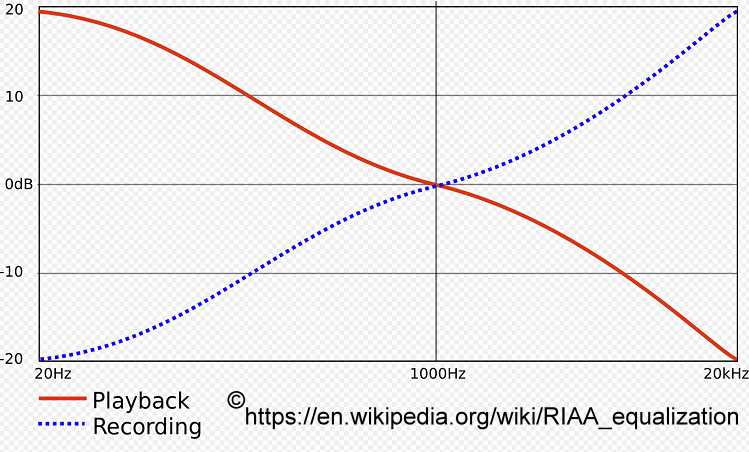
During vinyl playback, a Post-emphasis RIAA Curve is applied in the phono preamplifier. This is the inverse of the Pre-emphasis curve and is shown in the solid red “Playback” line in the graph above. In post-emphasis, the bass is amplified, and treble is attenuated. High-frequency attenuation reduces some noise, ticks, and pops that occur in playback because it is impossible to get the grooves totally clean.
Here is a chart listing the frequencies and amount of change at each frequency for the post-emphasis curve. This is the curve that a phono preamplifier applies. For the pre-emphasis, you would just reverse the + and -, for example, at 10 Hz, it would be -19.74 dB instead of +19.74 dB.
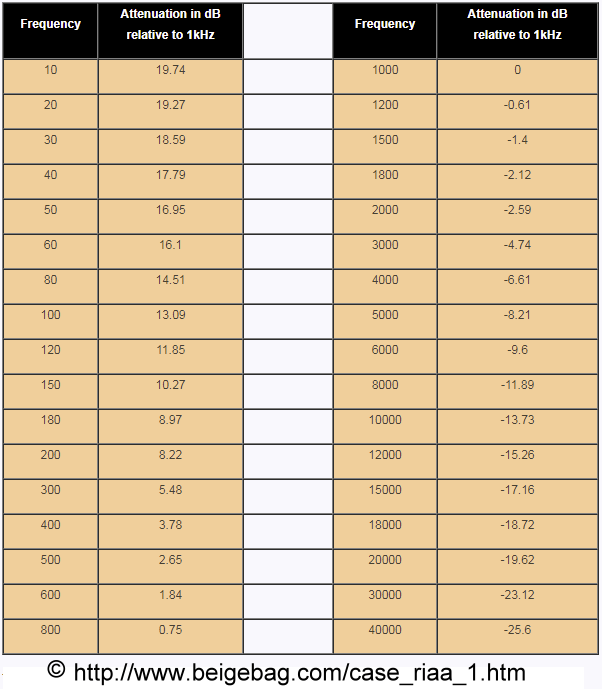
A phono preamplifier is similar to your main preamplifier, but it has much higher gain, and it also has the RIAA Post-emphasis circuit.
A phono cartridge, the cable to the phono preamplifier, and the load impedance have a combination of resistance, inductance, and capacitance as shown below in the top figure. As the frequency increases, so does the inductance, and the capacitance decreases. At a particular frequency, the inductance and capacitance resonate, resulting in a peak in the frequency response. The addition of a resistor reduces this peak.
The Pass Labs XP-27 has the ability to add resistance and capacitance in parallel with the output of the phono cartridge (at the input to the first gain stage). Resistance is available from 30 Ohms to 47 kOhms (9 steps), and capacitance from 100 pF (pico-Farads) to 750 pF (6 steps), adjustable using two control knobs on the front panel.
By changing the values of the load capacitance and resistance, we can alter the frequency response as shown in the second and third figures below. The second figure alters the resistance while keeping the capacitance the same, while the third figure alters the capacitance while keeping the resistance the same. So, you can change the entire sound of the cartridge by changing the values of the loading capacitance and resistance on the panel of your phono preamplifier (high-end phono preamps have this capability, while some, such as with receivers, built-in phono preamps might not have them). The figures below are for an MM (Moving Magnet) cartridge and are simulated.
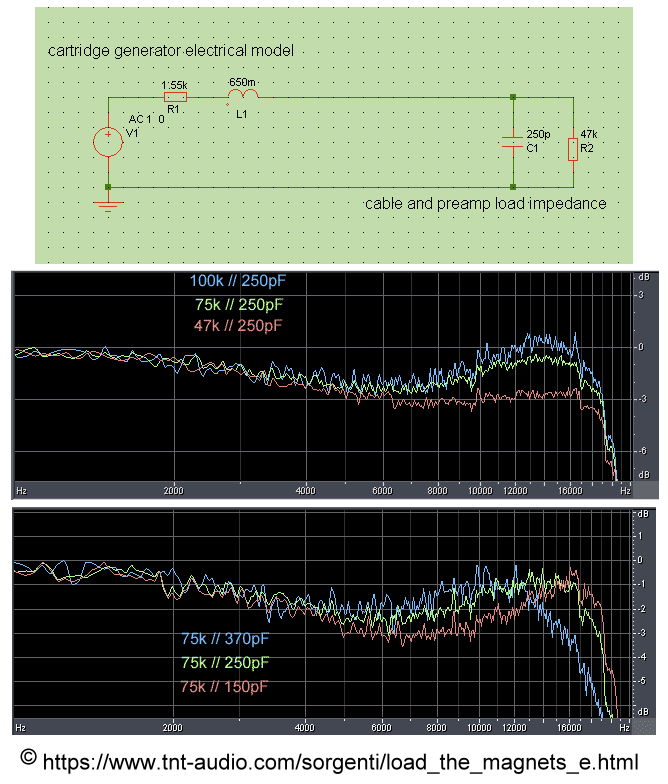
The bottom line here is that there really is not a “best” load setting from an electrical standpoint. You can play with the loads and listen to the sound. Use the load for which you like the sound. In fact, you might have a load setting with a particular album or set of albums and another one for other albums.
The RIAA curve can be applied passively or actively. For a passive use, the RIAA network is placed at the output of the phono preamplifier, and the response rolls off passively beginning at 10 Hz. An example of a passive post-emphasis network schematic is shown below. The RIAA networks are not simple, as the resulting curve is not a straight line.
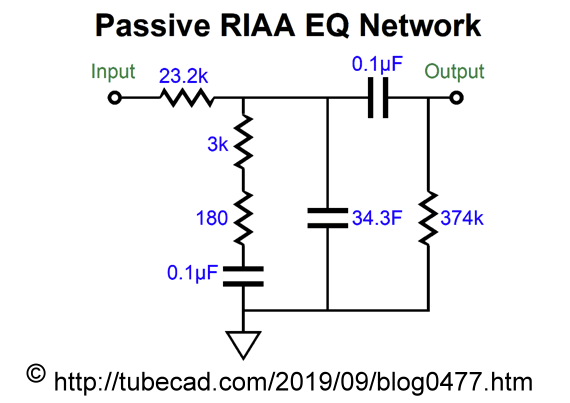
An active RIAA circuit is usually obtained by placing the RIAA network in the negative feedback loop. A generic negative feedback circuit is shown below. The RIAA network would be placed in the path between Vout, the Feedback Network, and the Subtraction point.
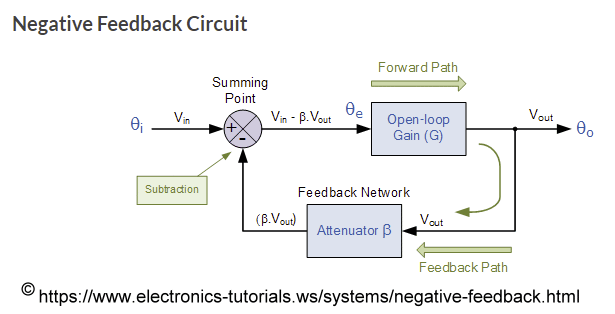
Due to the way the feedback loop interprets the RIAA network, the bass is actually amplified above the otherwise output level, and the treble is actively attenuated rather than simply rolled off. For the Pass Labs XP-27, only the bass portion of the RIAA network is in the feedback loop, so the bass is amplified, and the treble is simply rolled off. This is very unique.
The XP-27 has two high-gain stages, and they are so powerful, the transformer that is in some other phono preamplifiers to initially increase the gain is not needed. As a result, the XP-27 can amplify a phono cartridge that has only 40 µV (0.040 mV) output to sufficient levels. My reference phono cartridge, a Sumiko Palo Santos, has 0.500 mV output, and it is considered a low-output cartridge. There are three gain settings on the XP-27, adjustable with a control knob on the front panel: 53 dB, 66 dB, and 76 dB.
There are two sets of RCA inputs to select from, as well as a button to Mute the preamplifier (useful when changing inputs or changing the load settings), and a High-Pass button (“Rumble Filter”).
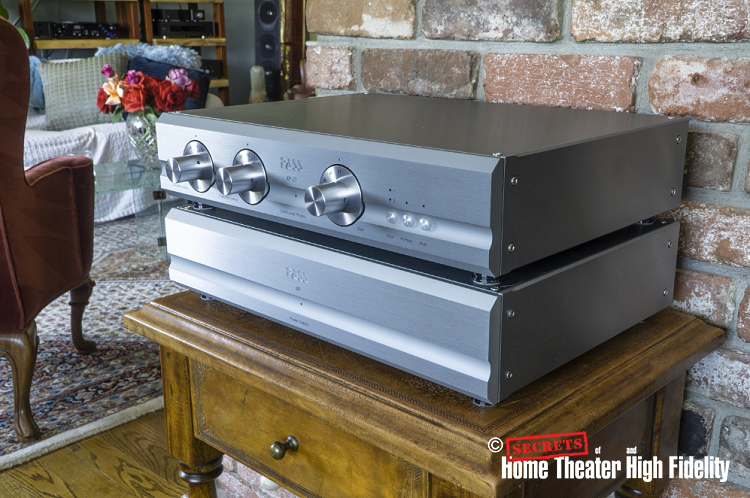
The rear panel has the 10 pin connector sockets for the included cable, which connects the power supply (lower chassis) to the signal path chassis (upper chassis). The cable is about 30” in length so you can separate the two chassis onto two different shelves of your equipment rack. This keeps the noise level as low as possible.

On the rear panel, there are two sets of RCA inputs (far right), a ground connector (to be connected to the ground connector on the turntable if there is one), one set of RCA outputs, and one set of XLR balanced outputs (I used the XLR outputs for my listening tests and bench tests). The three-pin 120 V input socket is switchable (on/off), but the XP-27 is designed to be on all the time, so the gain circuit is warm and optimal. You can switch it off if you plan to be, for example, on vacation.
I listened to the XP-27 with a VPI HRX turntable, Sumiko Palo Santos phono cartridge, Balanced Audio Technology VK-5i tube preamplifier, Balanced Audio VK-500 solid-state power amplifier, and Sonus faber Lilium Speakers. Also in use were Clarus Crimson Audio Cables, and a Clarus Concerto Power Conditioner with Crimson Power Cable.
Complete List of Reference Components: OPPO BDP-105 Universal Player (4), OPPO UDP-205 Universal Player (2), VPI-HR-X Turntable with Sumiko Blackbird MC Cartridge and Sumiko Palo Santos MC Cartridge, AURALiC ALTAIR G1 Digital Audio Streamer, Manley Labs Steelhead Tube Phono Preamplifier (2), Balanced Audio Technology VK-5i Pure Class A Triode (Tube) Stereo Preamplifier (2) (Fully Balanced), Balanced Audio Technology VK-500 Solid State Stereo Power Amplifier (Fully Balanced) (250 Watts per Channel), Pass Labs Xs Stereo Preamplifier, Pass Labs Xs 300 Monoblock Pure Class A Power Amplifiers (2) (300 Watts/each), Parasound JC 1+ Monoblock Power Amplifiers (2), Lamm LL1 Signature Stereo Pure Class A Triode (Tube) Preamplifier, MartinLogan CLX Full-Range Electrostatic Speakers (2), Sonus faber Lilium Speakers (2), Paradigm Reference Signature SUB 2 Subwoofers (2), Custom-Built Computer for Audio Analysis, Accupel HDG-3000 Digital Color Signal Generator (1080i capable), Component Video and DVI Output, ColorFacts Pro Video Test and Calibration Software, Version 6.0, Spyder Sensor, SpectraPlus Audio Analysis Software, Audio Precision SYS-2722 Spectrum Analyzer, Staco 3PN2210B-DVM 22 Ampere Variable Transformer (for adjusting line voltage to 120 volts during amplifier power output tests), Pass Labs XP-20 Stereo Preamplifier, Classé SSP-800 Surround Sound Processor, Emotiva XMC-1 Surround Sound Processor, Classé CA-5200 Five-Channel Power Amplifier (200 Watts per Channel), Pass Labs X600.8 Power Amplifiers (4) (600 Watts/Each), Audio Control Phase Coupled Activator (Sub-Harmonic Generator), Carver Platinum Mark IV Ribbon Speakers (2), MartinLogan Summit X Hybrid Electrostatic Speakers (2) (Rear Left/Right), MartinLogan Stage X Hybrid Electrostatic Speakers (3) (Center and Sides Left/Right), MartinLogan Balanced Force 212 Subwoofer, Velodyne DD-18+ Subwoofer (3), HiFiMAN HE1000 Planar Magnetic Headphones, OPPO PM-1 Planar Magnetic Headphones, OPPO HA-1 Headphone Amplifier, Bryston BUC-1 USB Converter, Sony VPL-HW55ES 1,920 x 1,080p Digital Projector, 90″ (Diagonal) Stewart Grayhawk Projection Screen, Sony 75″ UHD (4K) Flat Panel Display, Clarus Audio Cables, Clarus Concerto Power Conditioner with Crimson Power Cable.
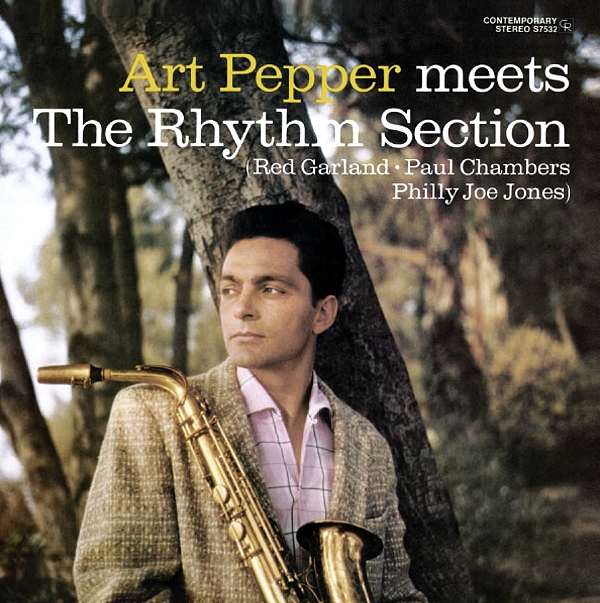
Art Pepper – Art Pepper Meets the Rhythm Section – Contemporary Stereo S7532; Analogue Productions APJ010; Original Jazz Classics – Released January 1, 2010
I have used this album for several product reviews because it is my favorite classic jazz album. It was recorded in 1957 using Neumann U-47 microphones. It has been remastered and is available in vinyl as well as several digital formats, including DSD. Pepper was a fabulous alto sax player having begun his musical training on clarinet when he was 10 years old. He played professionally starting when he was 17.
This album was recorded in the early days of stereo, so the instruments are placed in one channel or the other to emphasize the stereo effect. With the Pass Labs XP-27 phono preamplifier, I heard clarity and detail that I was not used to. As a drummer myself, I really was aware of the percussionist, Philly Joe Jones, and the rim clicks (where the drumstick hits the rim of the snare drum rather than the drum head) were so clear that it sounded like Jones was actually sitting a few feet away from me.
My favorite track on this album is “You’d Be So Nice to Come Home To”. It really sounded superb, and I finally am listening to a phono preamplifier that beats my reference which is a tube preamp that I have loved for years. Mind you, my tube phono preamplifier is excellent, sounding a bit “warmer” than the XP-27, but that is because of the tubes. However, the XP-27 has a clearer, cleaner sound with more detail, which I prefer.
Vinyl nay-sayers who state that digitally recorded music has less distortion, less noise, better frequency response, and better dynamics, don’t understand the appeal of vinyl. We know of its weaknesses, but the sound is wonderful despite all those things.
When I held a meeting at my home several years ago for about 15 people to discuss high-end audio, one of the things I did was to compare a vinyl recording (Miles Davis – Kind of Blue – Columbia Legacy) to its digital version side-by-side by switching back and forth between the two. This album is considered to be one of the finest jazz recordings ever made. All fifteen of the attendees preferred the vinyl. A couple of months ago, I replaced my phono cartridge with a new one, Sumiko Palo Santos, and played the Art Pepper album shown above. Again, I switched back and forth between vinyl and digital. I asked my wife Susan which version she preferred, not letting her know which one was which. She preferred the vinyl.

So, it’s not about distortion, dynamics, noise floor, or any other factor. It’s about the sound quality, and we vinyl guys (and some gals out there too), love it. That’s just the way it is. Vinyl sounds fantastic.

Art Pepper Quintet – Smack Up – Contemporary Records S7602; Analogue Productions – Originally Released 1962
This is another great Art Pepper album, recorded in 1962 and remastered for release at 45 RPM on vinyl. It adds Jack Sheldon on trumpet. The ultra-stereo effect had dissipated a bit by then, so Pepper is in both channels, centered. And, I do mean centered. The center imaging is so perfect, it literally sounds like he is coming from a center speaker. This is testimony to the XP-27’s perfect channel matching. The increased speed at 45 RPM does seem to add some detail and impact. The drummer’s ride cymbal is so silky smooth, I was speechless. This is very difficult to reproduce. It is not nearly like that on the digital version, and the vinyl played using my tube phono preamplifier only sounded sort of like the XP-27, but not quite. But getting up every 16.3 minutes to change the side of the disc (45 RPM remaster releases come as a set of two discs) is a pain.
That is one of the conveniences of a digital disc or even better, streaming. You can listen for hours on a streaming service without having to leave your seat, using your phone or iPad to add new albums to the queue, skip a track, etc. LPs at 33/1/3 RPM have a maximum of 22 minutes on each side, which is not as inconvenient. Just about the right amount of time to give my cat Nacho a belly rub before having to put him off my lap to get up. My cats love listening to the music system too. Their ears are very sensitive to distortion. Some years ago, when I was testing the limits of a speaker using a 10 kHz sine wave, my cat Buttons got off the chair and left the room. Stupidly, I kept testing and ended up burning out the tweeter. The manufacturer sent me a replacement, and fortunately, the tweeter was accessible with screws on the front of the baffle, unlike some (most?) speakers these days being mounted from the inside of the enclosure.

J.S. Bach – Sonatas & Partitas for Solo Violin – Nathan Milstein – Deutsche Grammophon – Remastered – Original Release Date 1975
Violin is a great instrument to test any audio system, and high frequencies are no piece of cake for a vinyl LP.
In any case, this set of violin Sonatas and Partitas is superb, and the XP-27 did it full justice. I have never been an avid fan of solo violin, but my interest went up a notch or two after listening to these Bach Sonatas and Partitas.

Tchaikovsky – Romeo & Juliet – Charles Munch, Boston Symphony Orchestra – RCA; LSC-2565 – Original Release 1962
This particular album is one of the first classical music recordings I ever obtained. My girlfriend Susan purchased it for me in 1964 as a Christmas present after I heard it in one of my music classes. She became my wife in 1968, and this morning (May 3, 2021), we listened to it with the XP-27. I sure don’t remember it sounding like this way back then. The full-bodied sound enveloped us like never before. I have heard it so many times, I know every note, but not like this. The XP-27 is really some audiophile component! I did not realize how much difference a superb phono preamp could make.
With the Romeo & Juliet album, I took the opportunity to adjust the resistance (100 Ohms) and capacitance (530 µF) loading to obtain what I considered to be an ideal sound balance with smooth highs and a solid midrange. I also found the perfect gain setting (66) which let me set the main preamplifier volume at 15 (medium-low). The gain is important because if it is too low, then increasing the main preamplifier volume will add noise. I have recorded the settings for future reference, as I will likely change them for other albums.
One thing I noticed that is much different than my reference phono preamp: when I adjust the resistance and/or capacitance load there, I have to manually mute my main preamplifier. Otherwise, there is a very loud pop. Also, when increasing the resistive load, the volume decreases. Neither of these is the case with the XP-27. That is due to the circuit design, which is different than a typical phono preamplifier. However, Pass Labs suggests turning your preamplifier volume down when changing the load settings. There is also a Mute button on the front of the XP27 to use when changing the load settings. I would concur with their suggestions, at least to start with. Don’t assume that just because I did not hear any loud pop when changing the load settings without reducing volume or pressing the Mute button, that you would experience the same thing with your main preamplifier.
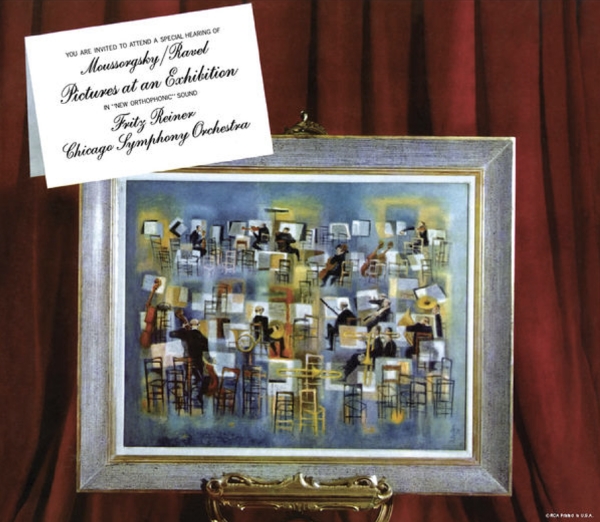
Mussorgsky – Pictures at an Exhibition – Fritz Reiner, Chicago Symphony Orchestra – Sony/RCA – Original Release 1958; Re-release March 14, 2014.
Pictures at an Exhibition is a suite of separate sections, composed for piano by Russian composer Modest Mussorgsky in 1874. It has been transposed for full orchestra here. There is also a Dorian digital release with all sections played on an organ, which I love, especially section II, “Gnomus”, but it is not available on vinyl, unfortunately. Nevertheless, this particular version on LP is excellent. Recorded in 1958, it was re-released in 2014, and I am continually surprised at how good some of the really old tape recordings are when put back onto new LPs for us vinyl aficionados.
The Pass Labs XP-27 is amazing in its capability to let vinyl shine. The musical theme in the first track, “Promenade I” is repeated in “Promenade II”, “III”, and “IV”, but with variations. Trumpets beam forsooth with luminance. Cymbal crashes have an exuberant sheen that is very realistic. “The Great Gate at Kiev” roars with thunderous grandiloquence. These last three sentences make me think I am reading other audio magazines too much.
I readjusted the resistive and capacitive load settings for this LP: 30 Ohms and 750 µF. As I mentioned previously, I did not have to mute the XP-27 or reduce the volume on my main preamplifier. The XP-27 automatically mutes while it changes the resistance and capacitance. And, I reiterate: reduce the volume on your main preamplifier and press the Mute button on the XP-27 before changing the load settings to start with, before you experiment with doing this without altering volume or pressing the Mute button.
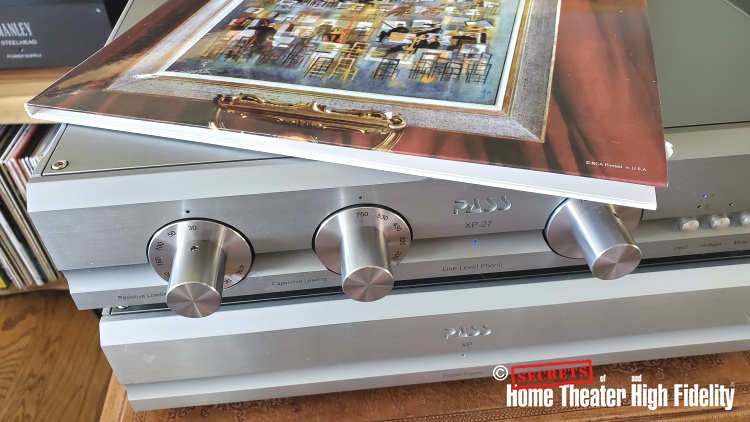
Let’s take a look at the accuracy of how the XP-27 conforms to the RIAA curve, shown below. The curved lines are the RIAA Post-emphasis performed by the XP-27. The straight lines are the frequency response of the XP-27 with Pre-emphasis added by the Audio Precision bench test instrument. I used two different load settings. The response is the same for the two settings except for the few dB difference in output voltages.
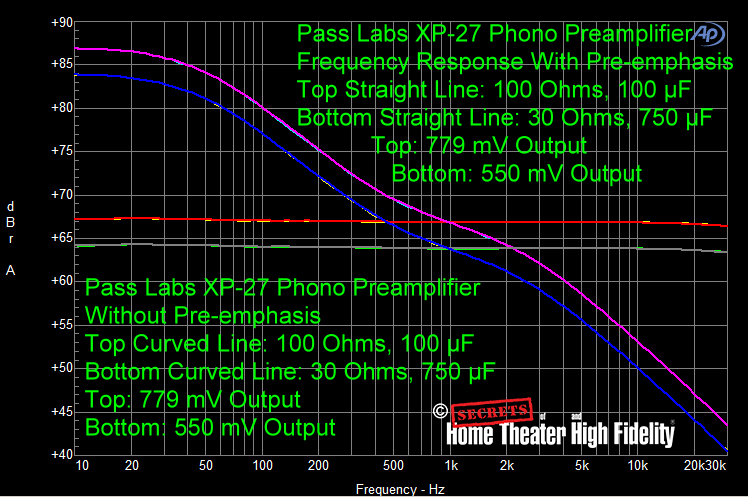
Expanding the Y-axis shows the curves with Pre and Post-emphasis. The frequency response is within 0.7 dB, 20 Hz to 20 kHz. Note that the frequency response includes the RIAA curve which can alter the effective response of the gain circuit. The bass is emphasized, and there is a slight accent of the upper midrange compared to the lower mids.
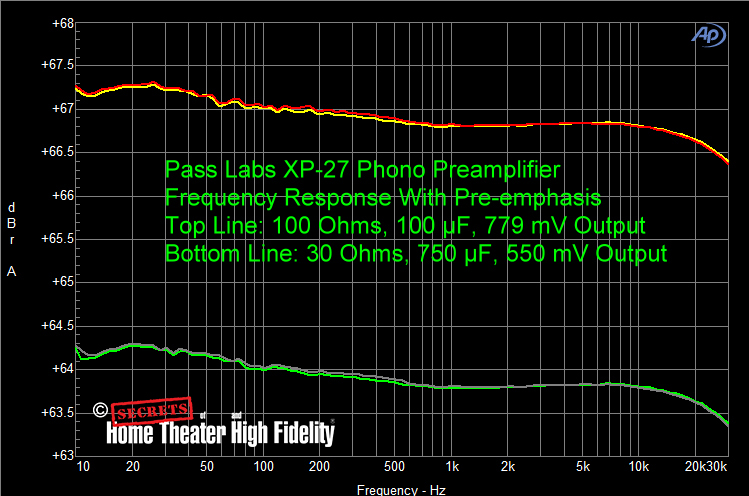
Here is an Impulse Response (IR) test on the XP-27. Output is 0.4 Volts.
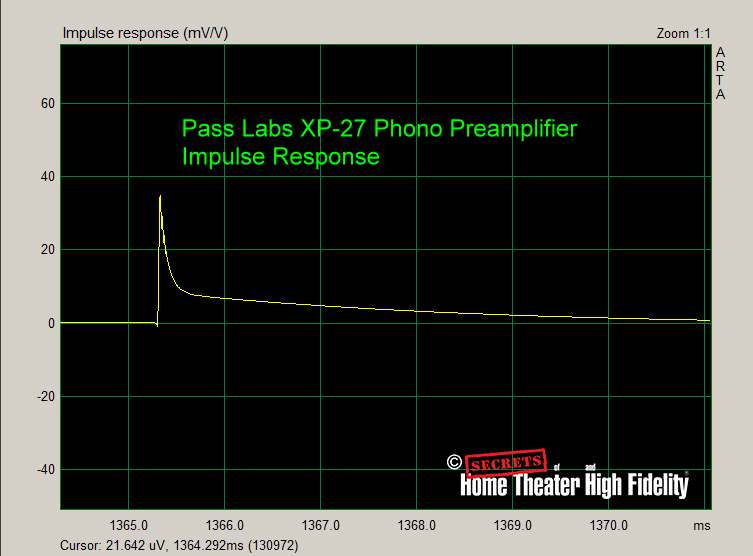
Using the IR to derive the Frequency Response and Harmonic Distortion, we get the spectrum shown below. The response out to 48 kHz is in the graph. It duplicates what we saw in the FR in the second graph above. Second-ordered harmonics (blue line) predominate out to the 20 kHz audible limits. This is similar to what we get with a tube circuit, so it is obvious that Pass Labs has done this on purpose. As I mentioned previously, the XP-27 does not sound quite as “warm” as my tube phono preamplifier, but the XP-27 does attempt to give the sound as much tube-like characteristics as is possible.
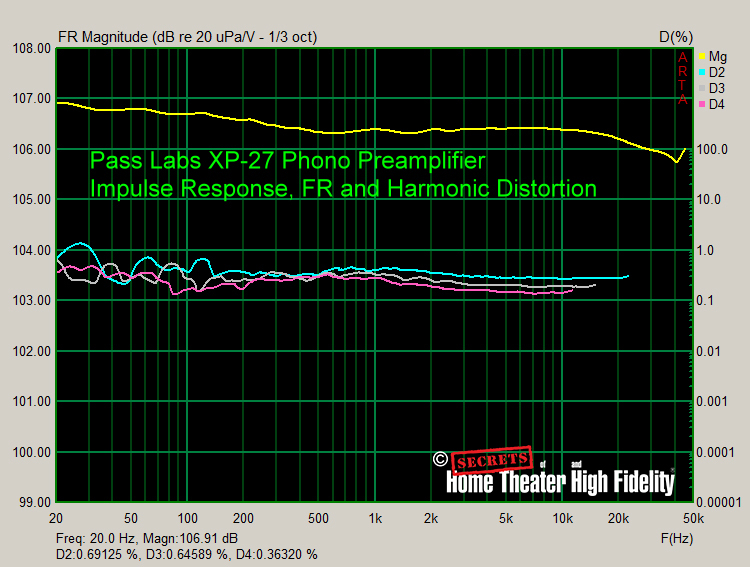
Looking at the noise floor, below is a spectrum with no test signal being input, using Input 1 and the Output. There are some 60 Hz and harmonic peaks. The basic noise floor is at – 50 dBV.
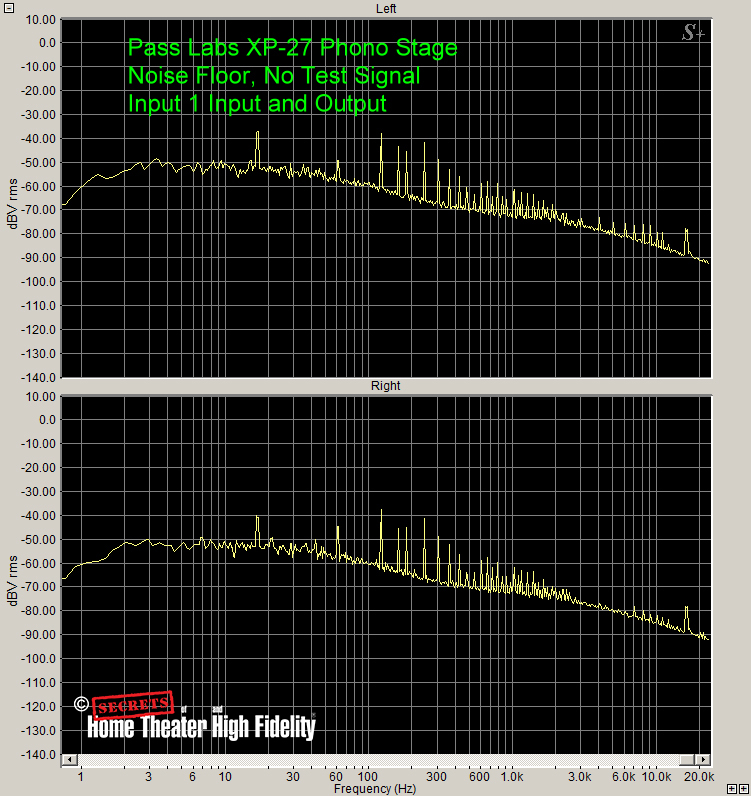
When we use the same input and output as in the figure above, but disconnect the RCA input cables, the following spectrum is achieved. The basic noise floor is now at – 70 dBV. So, the higher noise is due to the input signal, not the XP-27 gain circuit. A relatively high noise floor level is expected when such high gain is applied in any preamplifier, regardless of whether or not there is any input signal.
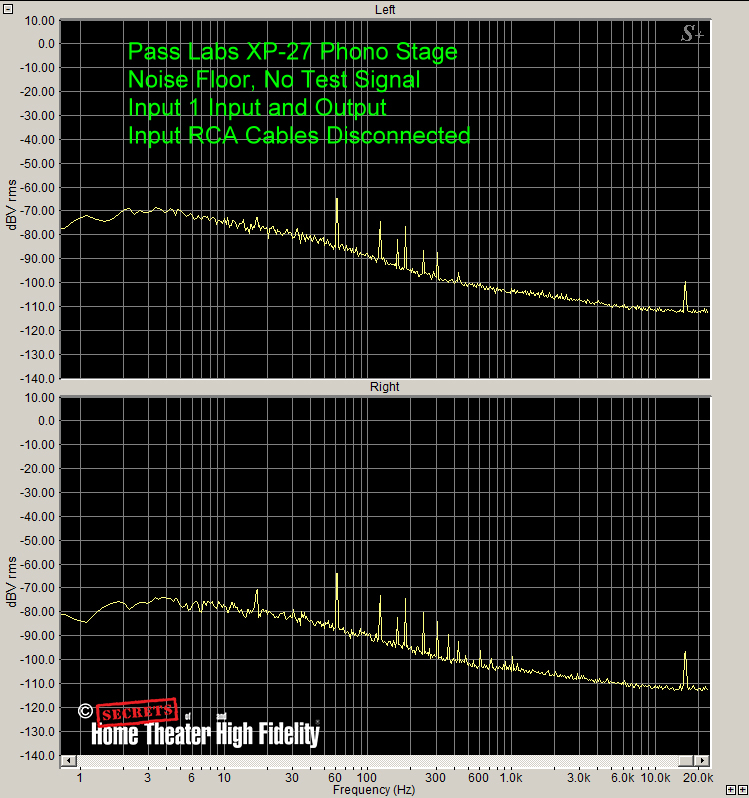
With everything connected, but the Mute button engaged, there is no output signal at all, shown below.

- Massive build
- Pure Class A bias
- Clear, detailed sound
- Separate power supply from gain stage chassis
- Larger LED indicators and labels (for my old geezer eyes)
The Pass Labs XP-27 design is the result of their very talented engineer, Wayne Colburn, and it is an exemplary product. When one gets to this level of performance, the difference between components is personality. One is not necessarily “better” than the others. It is a matter of preference. I think a high-end audiophile would find the XP-27 to be beautifully preferable. Massive? Yes. Runs warm? Yes, that is what Pure Class A does. Expensive? Yes, Massive, Pure Class A is expensive. Worth it? You bet.



